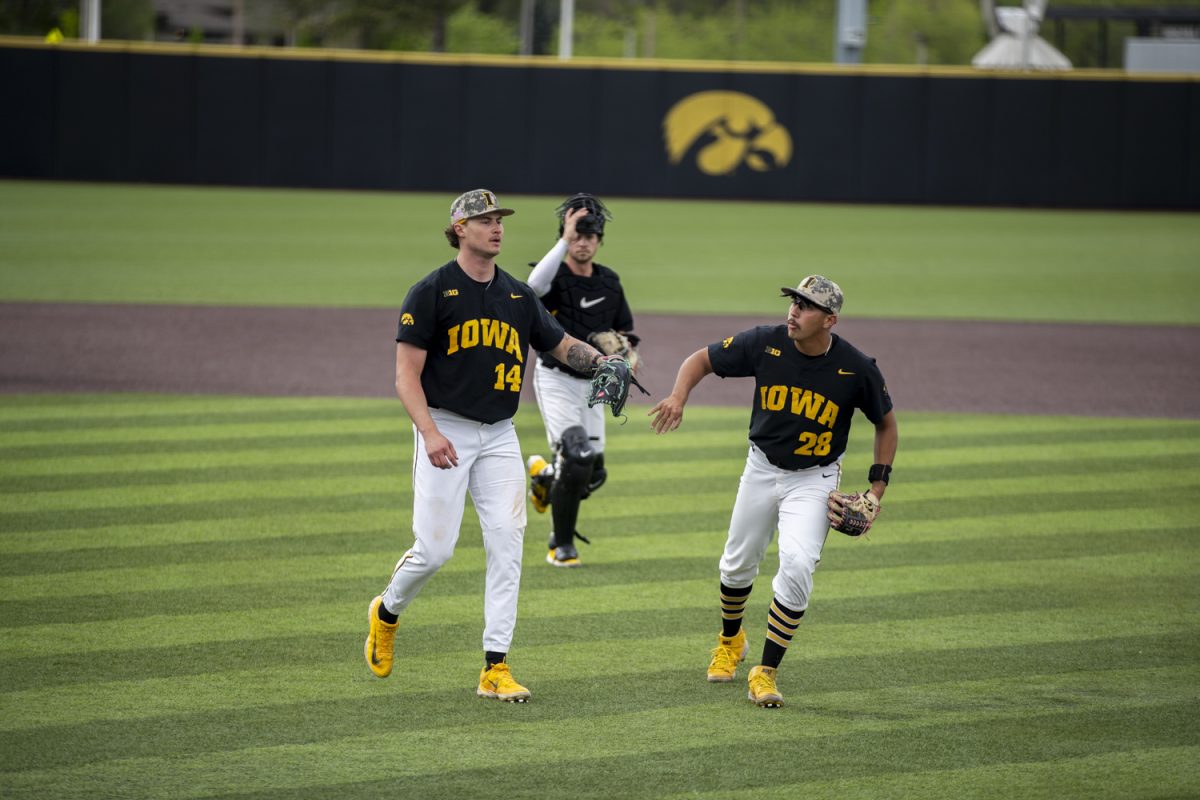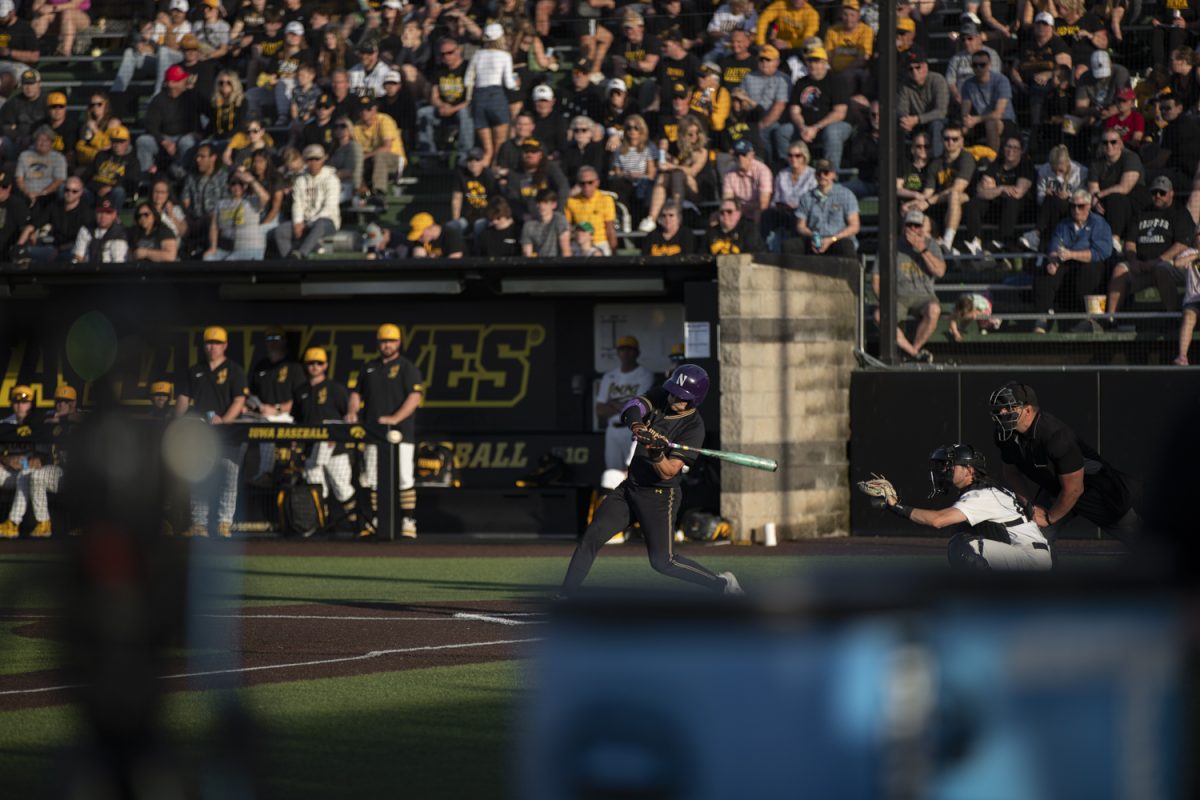On a chilly, overcast day at Banks Field, it is apparent that a familiar sound once synonymous with college baseball for nearly four decades has disappeared. The "ping" famously associated with the sport is no more.
Indiana traveled to Iowa City on a mid-April weekend for a three-game series with the Hawkeyes, and a new sound from hitters’ bats filled the air.
New bats have all but eliminated the ping, which has turned into a dull "thud." And batting averages, runs per game, and home runs per game are all down this season.
Division-I teams hit half as many home runs and scored 1.5 fewer runs, and batting average dropped more than 20 points — from .301 in 2010 to .279 this season, according to a midseason report released by the NCAA last month.
Iowa’s team ERA of 4.12 this spring is its lowest since the 1979 season, when the pitching staff recorded a school-record low 3.14 ERA.
This can be attributed to new bat regulations in college baseball, eliminating the hitter-friendly aluminum barrel and making the new bat perform more like wood.
Numbers don’t talk, they scream
Indiana outfielder Alex Dickerson — who led the Big Ten in batting average, home runs, and RBIs in 2010 — has seen a drop in his production. Through 47 games, the All-American has hit six home runs and is on pace to hit approximately seven or eight. He had 24 last season.
"I’m the kind of hitter that makes adjustments based on feel," Dickerson said after the third game of the Indiana-Iowa series on April 17. "Am I hitting this ball well, am I not hitting it well? But with these, you don’t get that feel off the bat. You can’t tell when you’re hitting it well or when you’re hitting it poorly.
"Being able to take consistent swings without being able to feel the ball off the bat is very hard to do."
Dickerson said the new bats’ weight was the biggest change he had to account for originally, and there was a clear difference between the old and new models.
The NCAA imposed the new bat standard called Ball-Bat Coefficient of Restitution, and it has resulted in the shrinking of the "sweet spot" on the bat’s barrel and has reduced the ball’s exit speed upon making contact.
"It’s more of a wood-bat game now," said Iowa second baseman and leading hitter Mike McQuillan, who is hitting .329 this season compared with .344 in 2010. "Most importantly, games come down to the small things, such as moving runners over and stuff like that."
Differences in opinion
The NCAA had an outlook similar to McQuillan when making the rule change. The baseball rules committee stated in January that the new regulations were put into place for two main reasons — player safety and integrity of the game.
In Eric Sorenson’s mind, there is no question that the rule change was positive. Sorenson, a national writer for College Baseball Today, said eliminating high-scoring games would have encouraging results soon.
"It’s been a long time coming," he told The Daily Iowan. "Anything that makes [the] sport look kind of freakish, I couldn’t stand. I was glad they made the change."
Unlike Sorenson, it’s taken some time for Iowa head coach Jack Dahm to become accustomed to the new bats and see the positives that come with the regulations. Dahm, who is in his 18th season coaching college baseball, said the NCAA never asked him his viewpoints on a potential change.
Baseball committee Chairman Jeff Hurd did not return numerous phone calls or e-mails asking if the NCAA consulted any coaches before the rule change, but Hurd said last month he’s received generally positive feedback.
"There is a tendency to say the game has changed," Hurd told the Associated Press. "Those of us on the rules committee prefer to look at it as if the game is being played more like it was prior to the advent of aluminum bats."
That style of play, Dahm said, is what boosted college baseball’s popularity over the last few seasons.
"If you asked college coaches before this season, they would have said the game was at an all-time high as far as attendance and interest from the fans," said Dahm, who was the head coach at Creighton for 10 seasons before coming to Iowa. "A majority of the coaches would have been against the new bats. I would have been against them also, because I thought the game was at a good point."
Offensive prowess — like Dickerson’s — is a part of that newly generated interest, but it is unknown if college baseball has lost that because of the new bats. One thing is certain, though, at least for Dickerson. The Poway, Calif., native said he would have rather the NCAA go to wood bats instead of the deader aluminum model, and he has strong beliefs about the new bats.
"I don’t really like them … These haven’t been tested through at the extent I think they should have been," Dickerson said. "Just the feeling off of it, you know when you’re hitting it well off the wood bat. Out of the [six] home runs I’ve hit this season, I’ve had no clue I’ve gotten any of them. You just have no clue when you’re hitting it well."
Peering into the future
There is no doubt whether coaches and players have to adjust to the new bats this spring, and both young and future players are the main beneficiaries of the rule change.
Many high-school athletics associations around the country are adapting the same or a similar rule as college baseball did, and Dahm speculated that bat companies would be able to improve their product under certain guidelines in the near future.
The regulations haven’t affected recruiting yet, according to Iowa coaches. However, play has been altered slightly from the Hawkeyes’ perspective.
"It hasn’t affected our style of play that much because we are a team that bunts a lot anyway," Dahm said. "I think we’ve probably bunted more this season than in other seasons. Part of it’s because of the bats, and the other part of it is that we just don’t have the team speed we’ve had in the past.
For aspiring professional players, using the new bat may bode for a better transition to pro ball, in which wood bats are required. Scouts may also have an easier time evaluating players in preparation for the major-league draft.
College baseball has changed this spring. While the ping may be gone, there is a sense that coaches and players will eventually be able to come to grips, literally and figuratively, with its newest offensive equipment.
"Hopefully, they’ll find a balance somewhere, and it will work out," Dickerson said. "This happens to be that [first] season, and it’s bringing a lot of numbers down, but it’s still baseball, it’s still the same game. You roll with it."






